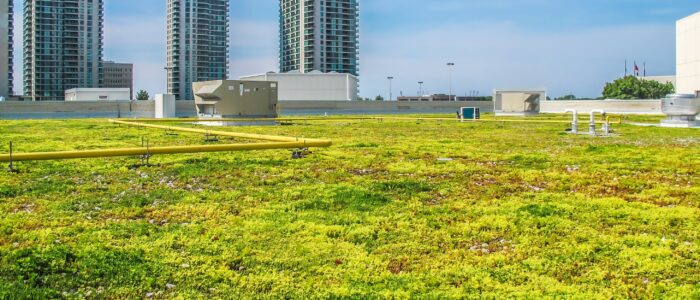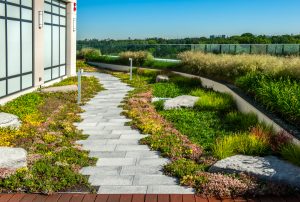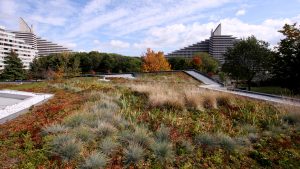Designing Extensive and Semi-Extensive Vegetated Roofs for Long-term Performance – Construction Canada Article
Read or print Construction Canada 2016 Designing for Long Term Performance
By Sasha Aguilera, B.Arch, GRP and Kees Govers, B.Sc.(Agr), GRP
Vegetated roofs are relatively new in Canada, with construction guidelines primarily brought over from Germany. Partially because of the climatic differences between Europe and large parts of Canada, there is a wide range of design options available to match the expectations of building design consultants, contractors, and owners alike.
Nevertheless, there are many areas in which virtually all vegetated roofing specialists converge in their recommendations, regardless of the systems they represent. The first and most obvious is to only build vegetated assemblies on roofing systems selected, installed, and detailed for that purpose, whether a new building or a retrofit. This includes ensuring the building has the applicable structural loadbearing capacity and the roofing assembly has appropriate wind uplift and fire rating, drainage pitch, cover boards, and flashings detailing to perform with a vegetated roof overburden. Especially important to vegetated roof installers is leak-testing. Selecting and installing appropriate roofing systems for use with vegetated assemblies has been the subject of a significant body of research and many articles as vegetated roofs have come into regular use over the last 15 years. (For example, see the Construction Canada article, “Waterproofing Considerations for Green Roofs,” by Karen Liu, PhD).
The other key recommendation lies at the heart of ensuring long-term performance of vegetated roofs—regular maintenance. As with all building systems and components, nothing is truly maintenance-free; virtually every component requires periodic maintenance to maintain its ability to perform according to the requirements set out during design. Since vegetated roofs are a living building assembly with periodic needs for moisture and nutrients (as well as removal of unwanted plants), these systems especially need regular upkeep. Ensuring regular maintenance needs to start near the inception of project design and be carried through the entire project process from design to building handover and beyond.
Budgeting and design
Vegetated roofs are no longer a novelty for obtaining additional points under the Leadership in Energy and Environmental Design (LEED) program—rather, they are now a design option for all buildings with clearly defined purposes in mind. As part of the design process, clear budgets should be established based on the type of system chosen, according to the parameters important for the building.
Although maintenance requirements can vary slightly with different designs and plant materials, each assembly comes with a fairly clear maintenance budget—both during the establishment period and long-term. Once the system has been selected, it should only be deviated from if its purpose changes. This ensures the system capabilities match the expectations of the design team and the client. A lot of technical information is available to make decisions related to planting types and performance, stormwater management capability, and wind uplift performance. These must all be taken into account when specifying a product, as well as approving alternates—when an alternate product’s claims look too good to be true, they usually are.
Ensuring access
All roofs with vegetation must be safely accessible for installation and green roof maintenance crews. Freestanding ladders as a means of access to a roof are neither enjoyable nor safe, especially when a maintenance crew also needs to haul up their tools and materials. With that in mind, one should ensure all roof levels can be reached with permanent stairways or ladders and/or window or door access. In addition, if parapets are less than 1 m (3 ft) in height, it is important to include roof anchors and permanent lifelines to allow construction and maintenance personnel to safely access the roof levels and perform their duties while tied off.
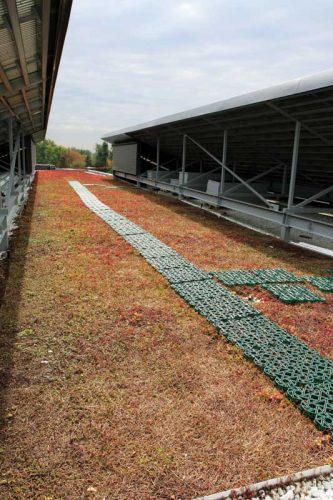
An example of temporary protection with grass pavers—sensitive plants need to be protected from rooftop maintenance traffic. Photos courtesy Liveroof
Once the safe access points to a roof are established, inclusion of designated work areas and pathways should not be overlooked. While many vegetated roofs in the extensive and semi-intensive styles are very visible, they are often inaccessible to anyone other than authorized personnel. However, this does not mean maintenance crews are the only ones with a need to access a vegetated roof area. Activities that are infrequent and low intensity, such as the maintenance of the green roof, do not require the installation of dedicated maintenance pathways. (The original meaning of ‘extensive’ and ‘intensive’ vegetated roofs was related to their maintenance requirements. The former had the least amount and lowest frequency of maintenance, while the latter had the highest [‘semi-intensive’ was a blend of the two]. The current meaning has been expanded to include growing medium depth. An extensive system is now defined as having a depth of up to 150 mm [6 in.] and planted with low-maintenance plants such as sedums, alliums, and related succulent plants with limited height (up to 300 to 450 mm [12 to 18 in.]).
Servicing of rooftop equipment, including those for mechanical systems and window-washing applications, are examples of two other functions that have to be performed atop the building.
Good design work can make it easier for service personnel to do their work without damaging the vegetation on the roof. The installation of pavers or ballast areas at access points and roof hatches goes a long way in reducing foot traffic damage in those sensitive areas.
Additionally, directing pathways toward regularly serviced equipment aids in avoiding traffic tracks across the vegetation. Providing appliance service technicians with a space at least 600 mm (24 in.) wide all the way around the curb of an appliance, with a minimum 1.2 m (4 ft) wide area immediately in front of the service panel, provides a clean work area without having to work on the plants and potentially misplacing equipment and parts in the process.
The use of swing stages above a newly installed vegetated roof should be discouraged. Nevertheless, where swing stages need to be landed and launched on a green roof area, the plants must be protected, as the frequency of foot and materials traffic will easily damage or even destroy the planted area used.
During construction, installation of the vegetated roof plants in these areas should be avoided until the other work is done, if possible. However, if the activities have to occur simultaneously, the plantings can still be protected with the use of plastic ‘grass driveway pavers,’ which can be put down atop the vegetation either temporarily or permanently. (The plants in the vegetated roof will grow through the holes in the pavers and all but obscure them if installed permanently.) When a swing stage lands on these pavers, the traffic only damages the portion of the plants showing above the edges of the pavers. The crowns of the plants are protected; this allows them to regrow after the work has been completed.
Water and irrigation
Closely related to the selection of the vegetated roof is the need for water and irrigation. Water requirements of the plants are closely related to climatic and weather conditions, as well as system design (e.g. plant selection, growing medium depths, and use of water retention layers). Not all vegetated assemblies require an irrigation system, but many do. The same roof that can be installed without irrigation in Vancouver or Toronto, almost certainly needs it in the climatic conditions of Kelowna, B.C., or Calgary.
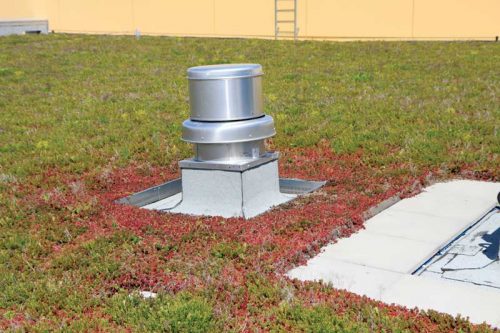
The design of a successful roof goes well beyond choosing plants and waterproofing. For example, direct exposure to air vents quickly dries out vegetation. Thoughtful placement of flora-free zones can help by making rooftop service work simple.
As was evident in Vancouver during last summer’s drought, a climate traditionally thought of as ‘cool, temperate, and wet’ does not guarantee a green roof will never need irrigation. Many vegetated roofs that received no supplemental water during the summer suffered serious drought damage. Until they are repaired and re-established, both the functionality and the esthetics of the system and the plants will be severely diminished.
Designs should always include water access on every planted roof level, as all vegetated roofs require water immediately after installation. Many systems also require temporary irrigation during the establishment period, which can be up to three years under certain circumstances. The hose bibs installed should supply sufficient volume and pressure to run at least a simple hose and sprinkler irrigation set up. If the design includes an irrigation setup connected to either a stormwater cistern or potable water, its designer and the mechanical engineer must work closely together to ensure appropriate volume and pressure is available.
In the authors’ experience, irrigation of extensive roof systems is accomplished with the highest efficacy with a professionally designed rotary sprinkler irrigation assembly. If the selected plants and system exceed a certain combination of height and density combined with deeper growing media depths, then micro-spray and drip irrigation often become better choices. Water retention fleeces can increase water storage in the system (thus reducing irrigation needs), and assist in the distribution of irrigation water across the vegetated roof for more even distribution.
Wind uplift and high-rises
Most vegetated roofs have been installed on buildings less than 10 storeys high. In these situations, plant and system choices are based on a limited number of design parameters. Once a vegetated roof installation is contemplated at higher elevations, numerous factors come into play that determine success.
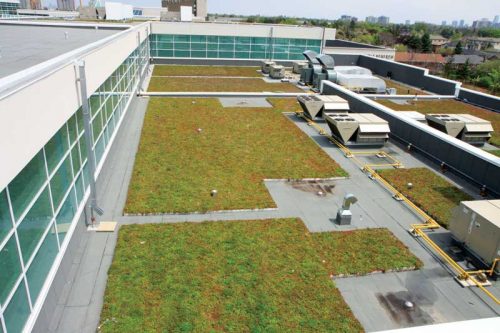
Splash pads and vegetation-free zones can be used to direct water from higher roof levels toward the drains. Space has also been left for gas pipes and rooftop units to allow for easier access and damage-free plants.
When designing vegetated roofs for tall and super-tall buildings, a number of additional considerations go into product selection, installation, and irrigation. (The Council for Tall Buildings and Urban Habitat (CTBUH) defines tall buildings as less than 300 m (984 ft) in height, while supertalls are 300 to 600 m (1970 ft). Megatall buildings are beyond that category). Since the recent introduction of Canadian Standards Association (CAN/CSA) A123.24-15, Standard Test Method for Wind Uplift Resistance of Modular Vegetated Roof Assembly, it is now possible to determine the suitability of a specific pre-grown vegetated roof system for application on a specific building. Comparing the wind uplift rating of the vegetated roof to the wind uplift study performed for the building answers whether it is suitable. (For more, see the Construction Canada article, “Designing Vegetated Roofing for Wind Forces,” by Jeff Truman, M.A.Sc., P.Eng., PMP).
What is not as evident are the other precautions for ensuring a vegetated roof thrives at high elevations, where wind is a much bigger factor than at lower levels. Not only does the wind have higher average speed and a higher gust speed because of the clear path around the building and the lack of shelter, but it also has a drying effect much more pronounced than at lower levels. In order to retain healthy plantings, even on extensive succulent green roofs, this drying effect often requires the inclusion and use of irrigation systems.
The management of the irrigation cycles is also important as the plants need to be well-hydrated entering the winter months to avoid the freeze-drying effect of high winds, low temperatures, and low humidity. Further, irrigation in the spring needs to start much earlier in the season than at lower levels. Unless tall screens are present, high elevation roofs do not have any significant snow accumulation—a major factor in winter moisture retention of the plants.
In addition to the constant drying effects of wind, there is always a concern for growing medium erosion at high elevations. The best way to avoid erosion is by using pre-grown vegetation, which allows the growing medium to be sheltered from wind. Plants are very effective at withstanding wind erosion as long as the roots are anchored into the growing medium.
The method of installation is also a factor in success. Due to the heights involved, installation with a tower crane or materials hoist are the only practical methods to transport the product to the rooftop. This means prior to the installation of the vegetated roof, all other major work at the roof level should be completed to prevent the destruction of the plants. Where construction activities are still required after the installation, the plants should be protected from foot and materials traffic as outlined elsewhere in this article.
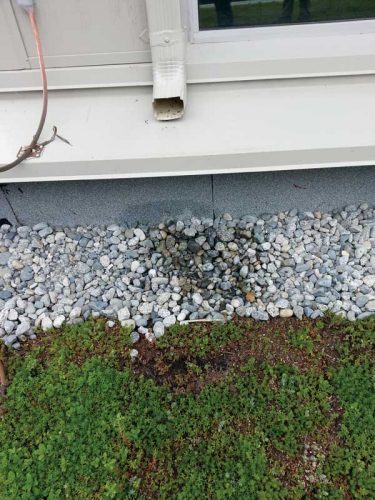
This close-up of a downspout shows the beginning of soil erosion. While it was beneficial to include the vegetation-free zone, it should have been larger. Photo courtesy Sasha Aguilera/Next Level Stormwater Management
Design for special problem areas
Roofs offer a harsh environment for plants, with vegetation often completely exposed to the elements with minimal protection from drying winds and intense sun. Further, plant survivability can be challenged by hidden stressors inadvertently designed on a roof. Generally, it is recommended to set back the vegetation from potentially damaging areas and in its place, create a ‘vegetation-free zone,’ traditionally comprising patio slabs or aggregates of 300 to 600 mm (12 to 24 in.).
Vents and water runoff
Direct exposure to air vents, whether warm or cool air, quickly dries out vegetation. Water travels through a plant’s stem to its leaves for critical life processes. Without adequate moisture levels in the plant’s foliage, its survival will be greatly challenged. At the same time, too much water can prohibit plant growth. While ponding water is obviously damaging to most green roof plants, water that drips or lands forcefully on the vegetation is also detrimental. Water rushing forcefully out of downspouts or consistently dripping off a higher rooftop will cause plant damage. Eventually, growing medium will be eroded, creating an environment impossible for thriving plants. Such areas should be vegetation-free zones and wide enough to bear the drying effects of vents or damage from direct water runoff.
Reflected light
Most plants grow best in full sunlight, but, again, too much of a good thing can prove harmful. In the case of vegetated roofs, an additional concern is intense sunlight in the form of reflected light. A glass curtain wall can reflect almost all the sunlight hitting it onto the vegetated surface at its base. This reflected light can cause growing medium to lose moisture, stunt plant growth, and cause a yellow-white ‘burn’ on the surface of foliage. To prevent plant injury from extreme levels of intense sunlight, particularly common along southern and western glass curtain walls, a generous vegetation-free zone should be provided.
Full shade
The vast majority of recommended green roof plants are sun-loving because, after all, roofs can be extremely hot with little respite from the sun. However, cities are becoming increasingly dense and have nowhere to go but up, leading to taller and taller buildings that may cast dark imprints not only on the streets below, but also on neighbouring rooftops. In such cases, a summer shadow study is useful to help determine whether the sun-loving plant list should be exchanged for a shade-tolerant one.
How many hours of direct sunlight are the minimum requirement for most sun-loving vegetated roof plants? Anything less than four hours necessitates shade-tolerant species, which typically have higher water and deeper-growing media requirements than the traditional list of sun-loving, drought-tolerant, vegetated roof plants. In their natural environment, shade-loving plants enjoy protection from the sun, reduced evapotranspiration rates, and higher soil moisture levels. A shady rooftop only meets one of the conditions for them to thrive.
Watering requirements are equally important. A generous and reliable watering regime needs to be provided by a permanent irrigation system on shady roofs. Shady and moist roof areas can become less-optimal environments for plant growth when air stagnates. It may seem impossible to have inadequate airflow on a vegetated roof because of its higher elevation, but lack of good circulation can be a concern at any height. This is especially true in cornered locations with constricted air movement. Stagnant air can promote foliar fungal diseases and other plant health problems.
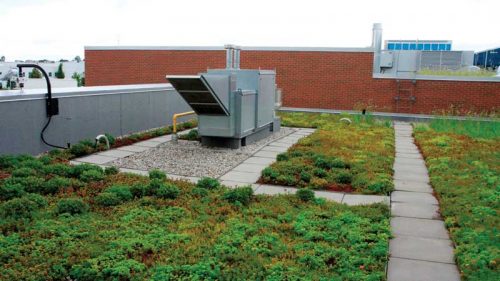
This photo shows a good example of how to create effective vegetation-free zones and access pathways to rooftop units and curbs. Photo courtesy Liveroof
Vegetated roof system details
Vegetation should be kept a safe distance away from any roof penetrations, in particular roof drains. Vegetation coverage, loose growing medium, or aggregates can obstruct the drain resulting in ponding water—this is not only detrimental to the health of green roof plants, but also, more critically, the building’s structural integrity.
As a general recommendation, vegetation-free zones should be maintained around all roof details, such as pipes, roof anchors, gas lines, and any other element that may require future inspection, maintenance, and repair. Distancing plants from these details not only protects them from disturbance during a repair, but it also allows for a more straightforward repair.
Lightning protection systems can pose challenges, for example. Flexible vegetated roof products can be draped over the systems, while more rigid vegetated roof products may require a level base, forcing the lighting protection assembly layout to be designed accordingly. If vegetation coverage must be designed in areas prone to disturbance, then it might be wise to choose a vegetated roof system that is simple to remove and reuse, as this could diminish the cost and time involved in repair work. An effective vegetated roof layout does not simply consider the esthetic function; rather, it considers the practical limits of the plants as well as the roof assembly itself.
Ensure high quality—in the bidding and in the awarding of projects
Vegetated roofs can be specified in several different ways based on the design parameters mentioned earlier in the article. Whether the consultant specifies with a pure performance specification, a basis of design (BOD) with named products, or a single-source specification, it is important bidders abide by the specifications and the rules for requesting alternates and substitutions as set out in the bid documents (i.e. Division 01). As mentioned earlier, it is possible to achieve the same goals in a number of different ways with a living building product such as a vegetated roof. However, since the consultant has written the specifications and prepared the drawings based on the goals on which the client and design team have agreed, it should be incumbent on the proponents of alternate systems to prove they can meet or exceed the design team’s objectives.
The authors have seen numerous occasions where either clients did not receive the product they had expected, or where contractors were in difficult situations because they carried a non-approved product in their bid. Neither situation is pleasant for the client, the consultant, or the contractor. Reading and understanding the relevant bid documents (i.e. 01 33 00−Submittal Procedures, as well as 07 33 63−Vegetated Roofing) is crucial to successful bidding and execution of projects.
Various vegetated roofing manufacturers insist contractors be licensed and approved before they are allowed to bid and install their systems. While not an absolute guarantee the subcontractor has carried an approved product, it is nonetheless a safeguard for general contractors and roofing or landscape contractors. It enables them to request a current licensing certificate from the bidding vegetated roofing subcontractor, along with a declaration it carries either an approved product or one meeting the requirements of the bid documents.
Since the short window in which bid closings happen can often be chaotic, it is usually best to carry the bids of a trusted subcontractor rather than the last-minute low bidder. Value engineering without consideration for the multiple factors going into the design and specification of a particular vegetated roofing system can lead to unexpected performance and maintenance issues.
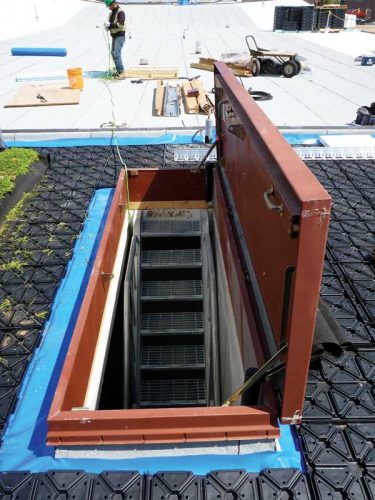
An example of safe access to the vegetated roof.
Care during construction
The green roof contractor should ideally be the last trade on the roof to minimize potential damage to plants, but it may be impossible to organize a construction schedule allowing this. Consequently, it is ever more critical for the design/construction team to be aware that although different plants have different thresholds for damage, most common green roof plants can tolerate only light foot traffic.
If pedestrian traffic is unavoidable, protective measures must be undertaken to diminish the impact of construction damage. Materials like plywood sheets or insulation boards may be laid over the vegetation temporarily to help distribute the weight of a person walking or equipment stored on the green roof. The protective material must be removed at the end of each workday to allow plants to recover overnight. Temporarily installed ‘grass driveway pavers’ in traffic areas can also greatly assist in protecting the vegetation.
In cold climates, particularly when temperatures drop below 0 C (32 F), foot traffic over vegetation must be avoided at all costs as frost-covered plants are susceptible to immediate damage. When foot traffic occurs on frosted green roof plants it can prove lethal, leaving foot-shaped patches of dead plants. The damage will be obvious the following spring; recovery may take several months or, in cases of severe damage, may not happen at all.
If traffic on the roof is necessary during winter, workers must restrict their movement to designated pathways and work areas cleared of ice and snow with plant-friendly materials such as sand, cat litter, or beet juice (this last one can cause some ‘pseudo-mould’ that might be esthetically off-putting, however). De-icing chemicals that can harm vegetation should not be used. Alternate plant-friendly options include freeze-protection systems such as heat cables installed under the patio slabs that are to be kept ice and snow free.
Post-installation maintenance training
As maintenance is key to any roof’s long-term performance, it is important the person assigned to visit and maintain the system is properly trained, has horticultural knowledge, and fall-arrest certification. Working on the roof differs from working at ground level, and certified maintenance contractors are therefore generally recommended for this kind of maintenance.
If it is decided green roof maintenance is to be done ‘in-house,’ maintenance staff should receive both initial and periodic training by the green roof installer or manufacturer. This should be hands-on training with easy to follow, step-by-step, guidelines that include:
- rooftop safety;
- project-specific plant/system information;
- troubleshooting recommendations; and
- maintenance checklists.
A comprehensive maintenance manual is an essential companion for personnel performing routine maintenance.
If the roof membrane needs to be repaired or rooftop units need to be added, the owner should inform the green roof manufacturer or the installer to co-ordinate the work with the roofing contractor. This ensures the vegetated roof is properly removed and replaced to minimize disturbance to the plants and growing media. Systems vary in the ease of removal and re-installation, as well as the plants’ recovery time. It is therefore important to employ contractors familiar with what has been installed.
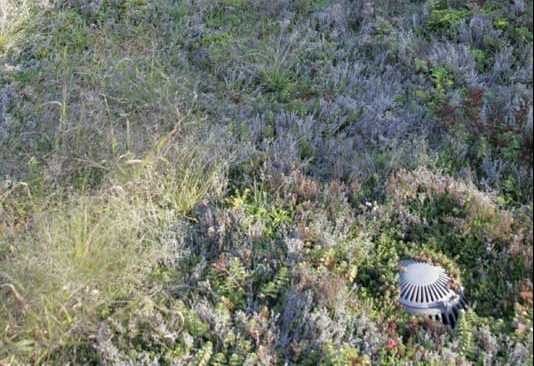 Vegetation and overburden warranties
Vegetation and overburden warranties
The vegetation warranty of any given vegetated roofing system will specify the expected performance, the warranty coverage, and the attached conditions. Under the Toronto Green Roof Construction Standard, for example, any vegetated roof has to achieve and maintain at least 80 per cent vegetation coverage within three years from installation. It should therefore be expected a vegetation performance warranty provides—at minimum—the same guarantee as the construction standard.
It is standard practice for the industry to provide clients with a vegetation warranty of at least two years from the date of installation. The limitations on the warranty stipulate the vegetated roof must be maintained according to the maintenance protocols provided by the manufacturer, with appropriate documentation of those maintenance activities. An experienced green roof inspector can generally determine the level of maintenance provided within minutes of seeing the project.
As discussed earlier in the article, damage done during the construction is not part of the coverage provided by these warranties. A vegetation warranty is specifically written for the post-installation period to ensure the selected plantings have an opportunity to mature and provide the required coverage while any bare spots in the vegetation will be patched as part of the maintenance required under the warranty.
Overburden removal and replacement warranties are typically warranty riders provided by roofing membrane manufacturers (or, increasingly, by green roof manufacturers) to clients to ensure that, in case of a leak in the membrane, the removal and replacement of the vegetated roof (overburden) is done at the cost of the warranty provider. Typical requirements, aside from a fee based on the length of the warranty, is the inclusion of a leak-detection system in the vegetated roofing assembly to provide quicker and easier location of the leak, thus reducing the area that needs to be removed and replaced for the repair. The overburden removal and replacement warranty will be of the same duration or shorter than the warranty for the roofing system on which the vegetated assembly is installed.
Conclusion
Across the country, vegetated roofs have become significant green technologies that solve a number of environmental challenges. To ensure excellence in performance, it is important the details in design and installation are considered as critically as the systems themselves. Attention to detail ensures long-lived, attractive, and well-functioning vegetated roofs for future generations.
Sasha Aguilera, B.Arch, GRP, is a client services and design consultant for Next Level Stormwater Management. A green roof consultant for nearly 10 years, she has considerable experience working with designers and contractors on vegetated roofs of various complexities, from retrofits to new construction. Based in Toronto, Aguilera regularly travels coast to coast, certifying installers and inspecting installations. Govers, B.Sc.(Agr), GRP, is the technical sales manager for LiveRoof Ontario Inc. He has had a long career in production management of large-scale commercial horticultural operations for woody plants and perennials before joining the LiveRoof green roof network in 2006. Govers has served on the London Chapter, the Growers Commodity Group, and the Provincial Board of Directors of Landscape Ontario; he is currently the director for the London Chapter of CSC.

